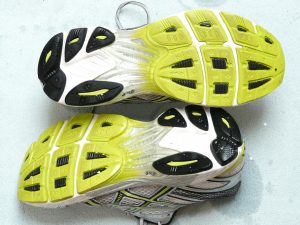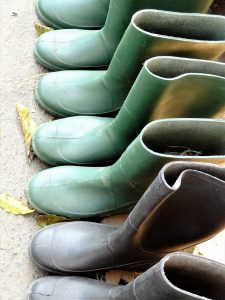Quick Navigation
Introduction
Human beings are the dominant species on the planet because we have learned and perfected the art of innovation over the centuries. All businesses and human-made institutions are geared towards the common goal of making life easier for people. We can agree that all the aspects of our lives have been affected by innovation somehow, and this fact also holds for footwear. In the past, shoes were made to protect the feet, and no particular thought was given to the other factors needed for perfect footwear. However, shoes are uniquely designed to do more than protect our feet today. They are designed to last longer and help us walk with extra comfort and stability. Two of the most important innovations today are slip resistance and oil resistance when it comes to footwear. Most shoes are designed with at least one of these two features, and we want to take a look at the reason. If you are interested in learning more about oil resistance and slip resistance in footwear, reading this article will help a great deal. Enjoy!
- What is Oil Resistance?
Oil has been used to power our lives and gives us constant electricity for almost a century. However, oil can be very counter-productive in some cases. If you work around a construction or oil drilling site, you will notice that they wear different shoes. The reason is that they have to wear shoes that can’t be affected by oil or other similar chemicals. Oil is a heavy compound, and when it comes in contact with your shoes, it can turn corrosive and damage them permanently. This is why some shoes are made with oil-resistant materials.
 Oil-resistant materials (usually rubber) are synthetic materials used in manufacturing different products (shoes, gloves, clothes) so that they don’t affect the products when they come in contact. When products are made with this kind of material, they are said to have an oil resistance feature. If your shoe is oil resistant, it will absorb or discharge oil when they come in contact. Instead of the oil to sink deep within your shoe and damage the structure, the rubber’s oil resistance feature will prevent that occurrence. If you are going to someplace with oily and messy grounds, you would be glad you wore an oil-resistant shoe. They are effective, durable, and incredibly easy to clean.
Oil-resistant materials (usually rubber) are synthetic materials used in manufacturing different products (shoes, gloves, clothes) so that they don’t affect the products when they come in contact. When products are made with this kind of material, they are said to have an oil resistance feature. If your shoe is oil resistant, it will absorb or discharge oil when they come in contact. Instead of the oil to sink deep within your shoe and damage the structure, the rubber’s oil resistance feature will prevent that occurrence. If you are going to someplace with oily and messy grounds, you would be glad you wore an oil-resistant shoe. They are effective, durable, and incredibly easy to clean.
- What is Slip Resistance?
If you think about it long enough, you would remember an occasion where you or someone you saw just fell while walking. This situation occurs often, and one of the significant causes is slippery shoes. When you are wearing shoes with low traction and a weak grip, you can easily fall if you walk on slippery or wet surfaces. These kinds of shoes do not usually possess a slip-resistant feature. Slip resistance is the element found on the sole of shoes that gives you better traction, more stability, and a firmer grip on any ground. Most shoes are designed with slip-resistant soles, but some shoes come with smooth soles. One good thing about slip resistance is that the owner of the footwear can artificially create it. If your shoe soles are smooth, you can employ several methods to make them slip-resistant. You can take it to your local cobbler, you can rub puff paint on the soles, you can apply traction spray, you can use sand or scuff the shoes manually, or you can do several other things. You can easily make your shoe slip-resistant, but you should be careful not to damage it in the process.
- Differences between Oil resistance and Slip resistance
Oil resistance and slip-resistance are two entirely different concepts. However, if we look at them from a footwear perspective, they have noticeable differences.
The first significant difference is that you cannot make your shoe oil resistant while you can alter your shoe to become slip-resistant. Some manufacturers design shoes to be slip-resistant and other manufacturers produce them with smooth soles. If your shoe is designed with slippery soles, you can easily employ various methods to make it slip-resistant. You can scuff the shoes, apply traction spray on the soles, apply rubber glue and salt, use sandpaper on the sole, and so many other options. Making your shoe slip-resistant is easy. However, oil-resistant shoes are made straight from the manufacturer, and if a shoe doesn’t possess the oil-resistant feature, you cannot alter it to that state.
Another significant difference between these two concepts is that while slip resistance only covers the shoe’s sole, oil resistance covers the entire structure of the shoe. This makes perfect sense because you need to protect your shoe from the harmful effects of oil, and you cannot do that if all parts are not oil resistant. Slip resistance prevents you from falling, and that requires designing the base of the shoe differently.
Lastly, while oil resistance is intended to prevent permanent damage to shoe, slip resistance aims to avoid damage to your body. Oil resistance shoes are durable, and they will last you for a long time. This is an advantage for construction and oil workers. However, slip resistance shoes are intended to keep you safe from slippery or wet grounds. Oil resistance is for the footwear, and slip resistance is for your well-being.
- Can footwear have both Oil Resistance and Slip Resistance?
This is excellent news right here. Any shoe can possess both oil-resistant and slip-resistant features. If a shoe is made with oil-resistant materials, it doesn’t mean the sole cannot be altered to be slip-resistant. Most oil-resistant shoes are slip-resistant because walking on oil might even make you fall if you are wearing slippery shoes. If your oil-resistant shoe is not slip-resistant, you can employ any of the methods above to make the sole less slippery.
Conclusion
Shoes are made to make our feet more comfortable. Most shoes are made with unique features, and these features most times include slip resistance and oil resistance. If you have been a little confused about the concept, we hope this article has given you all the information you need. When you buy a pair of shoes, you can easily recognize the value of what you are buying. Cheers!

